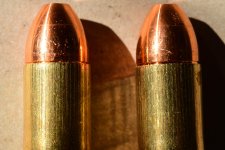They could well be an intentional, superficial marking.
at a guess, I would think that you've got a custom loading shop using new starline brass, and they might be running that "crimp" marking both to ensure that the case neck is sized and as a visual cue that it has been done.
Virgin brass MAY be ready to load when it comes out of the box, but my experience is that this is not a 100% guaranteed thing, so I FL size all my virgin brass before loading.
The commercial loading shop may not want to take that step, and may only be sizing the necks as part of the seating and crimping process. You'll have to ask them about that.
Starline is good brass, from your pictures the markings are not deep enough to affect the strength of the brass. Shoot them and load them normally.
IF a case mouth cracks (which, if you flare correctly isn't likely to happen), toss the case. IF you load is safe, case mouth cracking on firing normally doesn't harm the gun.
What you may find is the case mouth cracking when you flare it in the reloading process, and if that happens, all you lose is the case.
Always good to stop and ask everytime you have doubts or questions. In this case, I don't think you have anything to worry about, but that's just my opinion, and worth what you paid for it, or possibly less...


